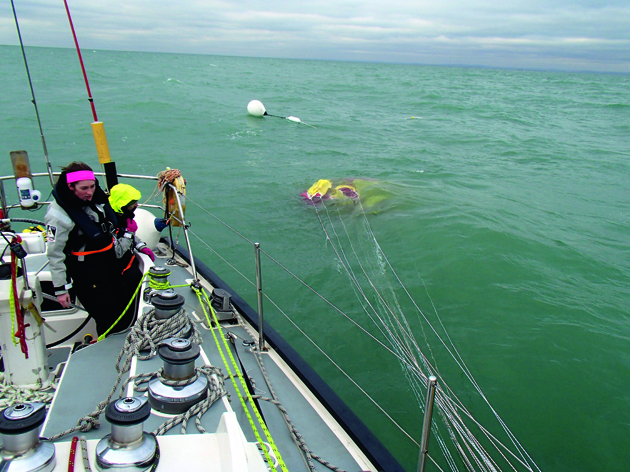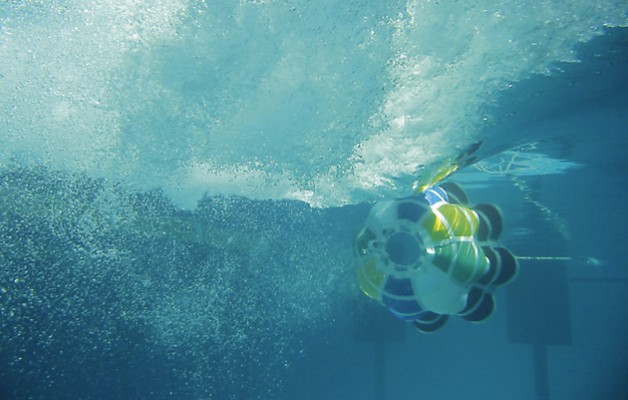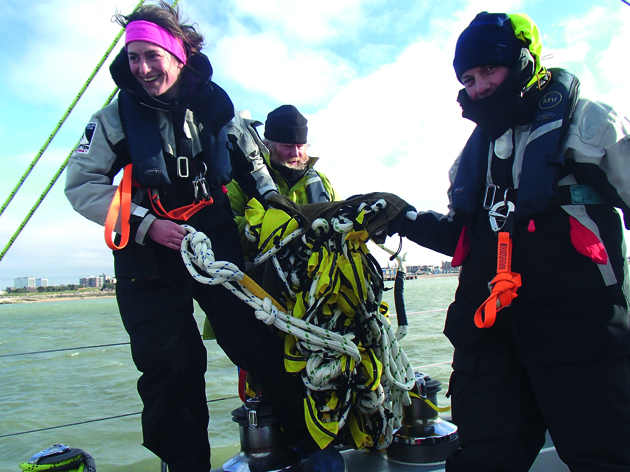Toby Hodges tries out a ParaAnchor sea anchor and a Jordan Series Drogue on a heavy weather sail training weekend in the English Channel
Drogues and sea anchors are designed to slow a boat or allow it to hold station in extreme weather conditions. They can prevent a possible capsize, roll or broach by keeping the bow or stern facing the weather. Debates about the pros and cons are rife among cruisers.
In Skip Novak’s Storm Sailing Series he reveals that he isn’t in favour of streaming warps, let alone using a drogue or sea anchor. Yet there are numerous testimonials from long-distance sailors who place their faith in these devices.
Intrigued to see how practical this equipment is to use, I joined Rubicon 3, a sail training and exploration company, during a heavy weather sail training weekend. I was particularly keen to see how easy it is to deploy and retrieve a drogue or sea anchor, and compare their benefits.
We sailed from Portsmouth aboard the 60ft Hummingbird, an expedition yacht built for the original Clipper Race in 1996. We needed to sail 15nm offshore into the English Channel to reach a depth of 20m to set the sea anchor, which has a diameter of 26ft, and find enough sea room to retrieve the 110m drogue. Once these contraptions are deployed, the yacht’s ability to manoeuvre is limited.
Bruce Jacobs, together with Rachael Sprot, founded Rubicon 3 to offer a unique crossover of adventure sailing and sail training. They had requested we muster early in the morning so we could check and load the equipment. They ran through the theories of using drag devices and how we would deploy and recover them.
“The main thing you have to look for when in heavy weather is breaking seas,” said Jacobs. “The boat can handle breaking waves if they are in the right orientation – 20° each side of the bow and similarly to the stern. The thing you don’t want to do is end up sideways to the sea.”
Choices in heavy weather
Yachtsmen have the choice of battening down and riding out extreme weather by heaving-to, forereaching, or lying ahull. But these techniques will not prevent capsize if a yacht is hit by a breaking wave.
There are three choices of purpose-made tackle to help keep a yacht stable in big seas: a single drogue towed off the stern to stop it surfing, a series drogue (a series of multiple miniature drag devices or cones on one line) or a sea anchor. The latter two are bulky, expensive items to ship, but are proven to keep a yacht bow or stern to the waves.
Jacobs explained that it is easier to keep a yacht stern on to waves as it sits better to the wind and is stable running downwind under bare poles. The counter argument is that the bow has been designed to point into waves, whereas the stern can poop and take waves into the companionway. Both the theories and test accounts of using series drogue and sea anchors are wide ranging.
“Most importantly, if you can keep a fit and healthy crew, you can get around bad weather,” said Jacobs. “If you can keep the boat stationary, then the average storm will blow through in 24 to 36 hours. But most people go with it, which turns that into three to four days, with a tired crew.”
A Force 5 wind against tide produced enough chop to make life uncomfortable on board. It demonstrated how quickly crew can become ill or tired. As soon as we dropped the main, the motion changed for the worse and we struggled for balance as we prepared the drogues. “Even here, where conditions are not severe, the choppy sea has made half the crew feel seasick and want to retreat into their shell,” said Jacobs.
Para Anchor
Sea anchors, also known as parachute anchors, are typically rigged from the bow to keep it into the wind. A sea anchor will hold the boat almost stationary, producing a very gentle downwind drift.
We trialled a ParaAnchor from Ocean Safety. The main towline is made from Nylon to keep elasticity in the system. A buoyed snag line improves retrieval and stops the anchor sinking. A parachute anchor has a huge surface area however, so its retrieval is not straightforward.
“We want the sea anchor to be on the same wave cycle as the boat, to rise and fall with the wave pattern,” said Bruce Jacobs, “otherwise you have huge snatch loads. So it’s worth keeping line in reserve so you can pay it out if you’re on a bad wave cycle.”
It is also worth double-checking the sea anchor is set up properly. Flaking out the line so it can run freely without snagging helps, but may not be practical. We paid out 100m of towline, which took up most of the side deck to flake. However, sea anchors are available with a deployment bag, which can simply be thrown into the water.
We rigged a bridle to help spread the load. Depending on hull(s) and keel shapes, the correct rigging of a bridle is an important factor in keeping a yacht head to wind. Ocean cruising veterans Lin and Larry Pardey advocate the use of a bridle with a scrap of sail to help prevent rolling. “Improvements may be found in leading it to an aft quarter cleat to allow you to trim it to an angle, or even putting up a scrap of main,” said Jacobs.
“One of the biggest causes of failure is chafe, so we also use a chain first to prevent this,” he added. The preparation and deployment of the ParaAnchor is time-consuming, but it certainly felt reassuring once in action. We drifted calmly, dead in the water, the motion instantly very much more comfortable.
The helm can be lashed and left once the anchor is set. A concern with sea anchors is that they can hold the bow too securely into oncoming waves, with the potential to shunt the boat astern. Allowing some flexibility in the helm lashing, by using a shock cord for example, provides a fuse to prevent rudder damage if this happens.
Other worries with sea anchors are that they place a lot pressure on the bow fittings. Cleats may need reinforcing with backing plates. If not under pressure a sea anchor can sink and pull the bow down. Equally, too much pressure means it may rise up and break the surface, so monitoring is needed.
When in the trough of a wave the towline can go slack and the yacht may yaw away from the wind – the reason the US Coast Guard could not recommend a sea anchor deployed from the bow in its 1987 report.
Jordan Series Drogue
A series drogue comprises a multitude of fabric cones spliced in series onto a line with a weight on the end. The original series drogue was designed by Donald Jordan and it is trailed from the stern. The purpose of a series or ‘medium drag’ drogue is comparable to a sea anchor in that it is designed to hold the boat near-stationary – to prevent capsize in the event of a breaking wave.
The number of cones is determined by the yacht’s displacement, but a typical Jordan Series Drogue (JSD) has between 100 and 200 cones of 5in (12.7cm) diameter attached to a tapered line. The load is spread across the multitude of cones, 172 in the case of Hummingbird’s JSD.
“The danger with the wind behind is pitchpoling,” explained Jacobs. “The JSD will hold you back, stop you from surfing and prevent that happening.” The yacht is still able to accelerate down the face of a wave, but the JSD will slow it enough for the wave to pass through without dropping into a trough. The drag force is applied softly, allowing gentle acceleration until enough cones bite.
The potential to be pooped is an obvious concern. Can the cockpit drain quickly enough? The drogue’s inventor says crew should be below, as steering is not required. So the companionway hatch needs to be sufficiently watertight.
The JSD can flake neatly into a mesh deployment bag. A bight between each cone is attached to the bag, bridle to one end and chain weight to the other. Deployment is then just a case of setting up the bridle on winches and paying it out. We were aboard a robust yacht, but once again I could appreciate the need to make sure the attachment points for the bridle are reinforced.
Once the drogue was set, the motion changed immediately. We went from rolling and lurching to comfortably taking tea in the cockpit, making 4.4 knots SOG, but just 0.1 knot through the water.
If the ease of deployment is a benefit of the JSD, its retrieval is its downside. Jacobs says it can take over an hour. But a snag line can be used, and during our trials retrieval took approximately 20 minutes with the aid of a winch.
“You have to find a method that is comfortable for you and your boat – and this [JSD] obviously is for Hummingbird,” said Jacobs. See also Jeanne Socrates’s article on those who have used a Jordan Series Drogue in anger
Conclusions
The trials demonstrated the value of preparation. Trying to sort out one of these drag devices, including the bridle and chafe gear needed, when the storm has already hit, would be daunting. So knowing how to set and use the equipment is key. It was also surprising to see how quickly a drogue or sea anchor can change the motion on board for the better, and the benefit this has on the mood and fatigue of the crew.
It is quite evident that, with practice, either could be a useful tool for riding out heavy weather. I remember setting a sea anchor during a Pacific delivery, for example, to stop the boat to cut a fishing net free from the stern gear. But during our trials with Rubicon 3, I found the series drogue easier to deploy and adjust than the sea anchor, with less to go wrong.
Prices and contacts
For a 45ft yacht of 15 tonnes displacement:
- Pacific 20 Para Anchor £1,829
- Yacht Drogue (single) £395. Both from www.oceansafety.com
- Jordan Series Drogue – 139 cones – £739 (Plus £82.40 for the bridle and deployment bag from £75) from www.oceanbrake.com
Also www.jordanseriesdrogue.com
See Skip Novak Storm Sailing Techniques Part 8 Drogues and Sea Anchors
Rubicon 3 – ‘sail’ ‘train’ ‘explore’
Rubicon 3 is owned and run by RYA Yachtmaster Ocean instructors Rachael Sprot and Bruce Jacobs. They bought Hummingbird two years ago.
“We wanted to do something different to what is already out there,” said Bruce Jacobs. “There is nothing really like what we do – you can typically only do adventure sailing or sail training, but this combines the two. It’s sailing with a purpose, sailing to get to great places.”
Their clients are typically aged between 35 and 60, around a quarter are new to sailing, and most sign up to sail on their own. The company has launched a series of Ocean Crossing Masterclasses. www.rubicon3.co.uk









